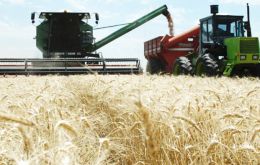MercoPress. South Atlantic News Agency
Tag: wheat
-
Tuesday, November 15th 2016 - 20:09 UTC
World cereal production remains strong; summer 2017 crops in South America expected to expand

World cereal production for 2016 should amount to 2 571 million tonnes, up marginally from FAO's October forecast and 1.5% above the 2015 output. The updated figure, released Monday in the Cereal and Supply Demand Brief, reflects a substantial upgrade of the outlook for world wheat production, which is now expected to rise to 746.7 million tonnes, a 4.3 million increase from FAO's October forecast.
-
Thursday, May 7th 2015 - 05:22 UTC
US for third year running main wheat supplier for Brazil displacing Argentina

For a third year in a row the United States will be the top wheat supplier for Brazil, displacing Argentina from its historic position, according to the latest release from Brazilian consultancy Trigo & Farinhas. This piece of information is significant given the world prices for grains and wheat planting prospects in South America.
-
Wednesday, October 23rd 2013 - 20:51 UTC
Wheat shortage in Argentina has seen bread prices skyrocket; Buenos Aires ton price is double Chicago's

In the last few days the Argentine news media has been focusing on the fact that there does not seem to be enough wheat or corn to go around, which is driving prices higher and causing concern for the users of these grains. This is particularly true for bakeries which have been forced to charge soaring prices for bread.
-
Thursday, September 26th 2013 - 06:51 UTC
Argentina expects a large crop of wheat next November despite recent frosts

Argentina is on track to harvest more wheat this season as greater acreage and coming warm weather should offset any yield loss caused by recent frosts that hit in the last days of the Southern Hemisphere winter.
-
Friday, July 26th 2013 - 04:34 UTC
FAO forecasts new record level of cereals production this year: 2.479m tons

World total cereal production is forecast to increase by about 7% in 2013 compared to last year, helping to replenish global inventories and raise expectations for more stable markets in 2013/14, according to the latest issue of FAO quarterly Crop Prospects and Food Situation.
-
Thursday, July 18th 2013 - 08:45 UTC
Argentina 2012/2013 crop expected to reach a record 105 million tons says Cristina Fernandez

Argentina’s 2012/2013 grain and oilseed crop reached a record 105 million tons, announced President Cristina Fernandez underlining the excellent performance of the maize harvest and yields.
-
Friday, July 5th 2013 - 03:45 UTC
Argentina prepares to confiscate wheat stocks to ensure bread supply at ‘normal prices’

Argentina Domestic Commerce Secretary, Guillermo Moreno has given mills and exporters until Friday to normalize the wheat market which has been under stress with bread prices doubling in the last month, and farmers’ complaining about the worst harvest in decades because of government policies.
-
Wednesday, April 17th 2013 - 07:35 UTC
Argentine farmers expected to plant more wheat this coming season

Argentina will plant more wheat this season than last year because of farmer-friendly adjustments to the government’s export policy and the bad luck that growers had last season with alternative crops such as barley, a key grain exchange said.
-
Wednesday, March 20th 2013 - 08:22 UTC
FAO first wheat forecasts for 2013 anticipates second largest crop on record

First forecasts for the 2013 wheat harvest point to production increasing to 690 million tons, 4.3% up on 2012. This would be the second largest crop on record, according to the latest issue of FAO quarterly “Crop Prospects and Food Situation” report. The production hike is expected mostly in Europe, driven by increased plantings in response to high prices and a recovery in yields in some countries, notably the Russian Federation.
-
Thursday, December 27th 2012 - 06:01 UTC
Xmas rainstorms and soggy soil delaying soy and corn planting in Argentina

Christmas rainstorms across Argentina further delayed soy and corn planting, keeping markets guessing about whether the grains powerhouse can produce enough this season to help bring high-flying global food prices down to earth.
